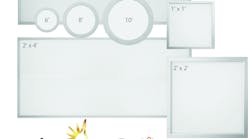The first topic on the agenda at The LED Show conference in Las Vegas questioned whether LEDs could continue to advance at the same rate in terms of lumen output and efficacy as they have in recent years. The presentations, however, focused more on how to meet solid-state lighting (SSL) system quality and cost goals with different LED technologies.
The speakers included Chad Stalker, regional marketing manager for the Americas at Philips Lumileds; Erik Swenson, manager of LED sales at Nichia; and Paul Scheidt, product marketing manager at Cree. The three had decidedly different ideas about how LEDs and SSL systems will evolve.
Stalker said up front that future efficacy advancements will come more at the system level than the component level. He said that LEDs will continue to improve but at a slower rate. He added, "LED systems will continue to drive the improvement."
Much of Stalker's presentation, however, covered advancements at the component level, outside of efficacy, that both can improve system efficacy and also deliver better quality light. He said better red LEDs mixed with phosphor-converted white LEDs are critical. He also said that the lime-green LED used in the Philips Hue lamps is an example of the trend in a color-tunable product.
Mid-power push
Nichia's Swenson, meanwhile, focused almost exclusively on mid-power LEDs. He said that those components are improving more rapidly than high-power devices in terms of efficacy and offer better quality and aesthetics that better match many application requirements.
Swenson also said that mid-power devices have an economy of scale advantage that high-power devices can never match. He said that the Nichia 757 LED is used in applications ranging from streetlights to retrofit lamps to display backlights to automotive applications. That broad applicability will presumably deliver an increasing cost advantage.
Mid-power LEDs also offer a yield advantage in manufacturing, according to Swenson. His reasoning was that if you have the same number of bad die on mid-power and high-power wafers, with far more mid-power LEDs per wafer, then the mid-power yield is better. That argument rang hollow, however, because a bad area of a wafer could easily impact multiple mid-power die.
High-voltage LEDs
Cree's Scheidt took the stage and, like Stalker, focused on the system-level problem. And early on he identified LEDs as less of an issue in terms of system cost relative to other things such as drivers, thermals, and optics. Indeed, the percentage of SSL system cost attributable to LEDs has steadily dropped for a number of years.
Scheidt set out to consider different ways to address the system cost issue using different types of LEDs and different system architectures. He considered the AC-LED approach since that technology presumably eliminates the driver part of the cost equation. But Scheidt said AC-driven designs require more LEDs because not all of the LEDs are driven at any point in time. He also said AC systems have flicker problems that simply can't be solved and EMI problems that require extra circuitry or essentially a driver IC. In a future article we will get commentary from Seoul Semiconductor on those claims.
Turning to mid-power LEDs, Scheidt said that in many cases the LEDs will shift in color with unacceptable results in as little as two years. He said the problem is especially significant as you drive the LEDs harder and try to limit the number of LEDs in the system.
Most of Scheidt's comments on mid-power devices were directed at LEDs in plastic packages. It's worth noting that Nichia said its 757 LED actually utilizes a ceramic-composite package. The company has not revealed details of the formulation, but Swenson has previously said that the package delivers lumen and color maintenance that can match high-power LEDs.
Scheidt concluded that in many applications such as retrofit lamps, high-voltage, high-power LEDs offer the best system-level approach. He said such components simplify the driver design and also match the application requirements of light distribution and quality. In fact, Scheidt said that SSL products such as streetlights and ceiling troffers, which use large numbers of single-emitter LEDs, have always been high-voltage designs at the driver level. And those products are broadly successful and feature SSL-industry-leading system efficacy.




